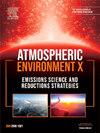Cement and brick factories contribute elevated levels of NO2 pollution in Nepal: Evidence of high-resolution view from space
IF 3.4
Q2 ENVIRONMENTAL SCIENCES
引用次数: 0
Abstract
An upsurge in the pollution level in areas with a high concentration of brick and cement factories in Nepal is concerning. Nitrogen dioxide (NO2), a key air quality indicator, can be effectively monitored from space. This study utilizes high-resolution satellite observations of NO2 from the TROPOspheric Monitoring Instrument (TROPOMI). It examines the NO2 distribution over areas with emerging sources of nitrogen oxides from brick and cement factories from 2018 to 2021. Rapid growth of brick and cement factories has turned the Lumbini-Butwal-Palpa corridor, in Midwest Nepal, more polluted than the capital city Kathmandu. Between 2019 and 2021, NO2 levels in this corridor rose considerably, while it remained steady in the Kathmandu Valley. TROPOMI-derived NO2 levels and inferred NOx emissions over the corridor nearly doubled in the span of three years. Conversely, Kathmandu Valley exhibited no significant changes except in 2020 when NO2 and NOx levels declined. This drop coincided with COVID-19-related travel restrictions and other reduced activities. NO2 pollution recorded by the Ozone Monitoring Instrument (OMI) from 2005 to 2019 shows an annual NO2 increase of ∼3.5 % over both regions. A comparison between NOx emissions from the 2018 EDGAR inventory and TROPOMI-derived estimates for 2019 reveal comparable values over the Lumbini-Butwal-Palpa corridor but around 35 % higher estimates over Kathmandu. This discrepancy over the capital city, as well as the rapid rise in emissions over the Lumbini-Butwal-Palpa corridor due to a large-scale development of cement and brick industries, highlights the need for timely updates in bottom-up emission inventory.
水泥和砖厂导致尼泊尔二氧化氮污染水平升高:来自太空的高分辨率视图的证据
在尼泊尔砖厂和水泥厂高度集中的地区,污染程度急剧上升令人关切。二氧化氮(NO2)是一项关键的空气质量指标,可以从太空有效监测。本研究利用对流层监测仪器(TROPOMI)对二氧化氮的高分辨率卫星观测。该报告调查了2018年至2021年砖厂和水泥厂产生氮氧化物的地区的二氧化氮分布情况。由于砖厂和水泥厂的快速增长,尼泊尔中西部的蓝比尼-布特瓦尔-帕尔帕走廊的污染程度已经超过了首都加德满都。2019年至2021年期间,该走廊的二氧化氮水平大幅上升,而加德满都谷地的二氧化氮水平保持稳定。从tropomi得出的二氧化氮水平和推断的氮氧化物排放量在三年内几乎翻了一番。相反,除了2020年NO2和NOx水平下降外,加德满都谷地没有明显的变化。这一下降恰逢与covid -19相关的旅行限制和其他活动减少。臭氧监测仪器(OMI)从2005年到2019年记录的二氧化氮污染显示,这两个地区的二氧化氮每年增加~ 3.5%。将2018年EDGAR清单中的氮氧化物排放量与tropomi得出的2019年估计值进行比较,发现Lumbini-Butwal-Palpa走廊的氮氧化物排放量相当,但加德满都的估计值高出约35%。首都的这种差异,以及蓝毗尼-布特瓦尔-帕尔帕走廊由于水泥和砖工业的大规模发展而导致的排放量迅速上升,都突出了及时更新自下而上排放清单的必要性。
本文章由计算机程序翻译,如有差异,请以英文原文为准。
求助全文
约1分钟内获得全文
求助全文
来源期刊

Atmospheric Environment: X
Environmental Science-Environmental Science (all)
CiteScore
8.00
自引率
0.00%
发文量
47
审稿时长
12 weeks
 求助内容:
求助内容: 应助结果提醒方式:
应助结果提醒方式:


